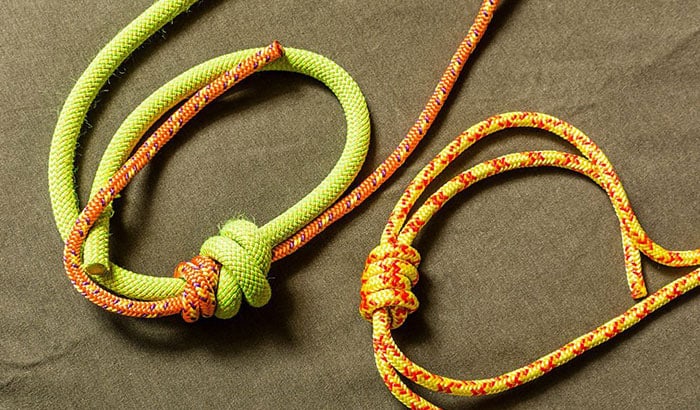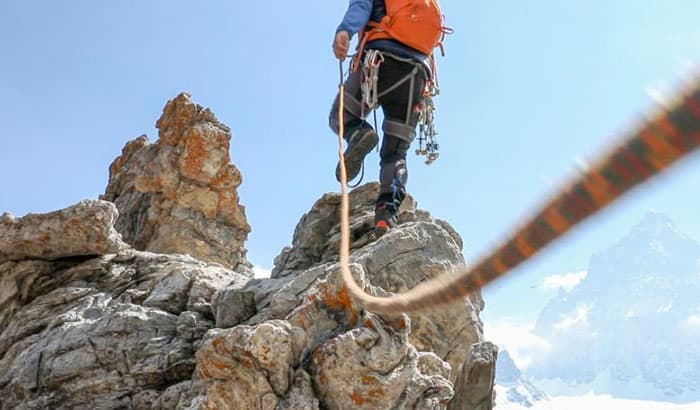In any climbing activity, a climbing rope is an essential tool for every climber. But a climbing rope comes in two different types: static rope and dynamic rope. Each of the two ropes comes with a specific purpose and use for every climber.
So, what is the difference between static rope vs dynamic rope? There are many features which differentiate between dynamic and static rope. Each of these features will be discussed in this article to allow new climbers to be familiar with static and dynamic rope.
| Features | Static Rope | Dynamic Rope |
| Elastic Stiffness | Little to No Elasticity | Built with Elasticity |
| Usage |
|
|
| Variety | Very Few | Several Options |
| Colors | Mostly White and Black | Mostly Shiny and Colorful |
Elastic Stiffness
Also known as elongation rope, the static rope is built to have a small amount of stretch. In other words, it is not designed to stretch when there is a load. This rope was made to provide a steady and strong hold when used in a climbing activity.
A good example is when a climber uses the rope for rappelling, you will see no bouncing movement, which helps give the climber more control of the movement during the descent. There is also a semi-static rope which has an elasticity rate of 15% and can support and absorb the weight.
Meanwhile, the dynamic rope is built to be elastic when used in a climbing activity. It is designed to provide a high amount of elasticity which helps protect a climber when falling and avoid serious injury.
Dynamic ropes come with an active feature which means rope can absorb the energy coming from a sudden load very quickly compared to static rope. The effect is a reduced peak force that lessens failure and the risk of injury.
Type of Climbing Activity
When learning the difference between static vs dynamic rope, one must consider the usage of its rope for particular climbing activities. Each rope can be used in a specific climbing activity, depending on how a climber will use it.
For a static rope, there are many applications that can be used, such as abseiling, caving, rappelling, canyoneering, and even fire rescue operations. Since static rope has very low static properties, it can allow the climber to have a bounce-free and more controlled descent.
With its elasticity features, the dynamic rope is perfect for rock climbing, mountaineering, lead climbing, and ice climbing. Some people also use the dynamic rope for top-roping activities because the rope’s feature is perfect for top-roping. The below table is the summary of a climbing activity that can be used with each type of rope.
| Static Rope | Dynamic Rope |
| Caving, Abseiling, Canyoneering, Rappelling, Fire Rescue Operations | Mountaineering, Rock Climbing, Lead Climbing, Ice Climbing, and Top Roping |
Primary Usage
You can also tell the difference between a dynamic rope and a static rope by the primary usage it can give to the climber. If you want a rope that will secure and make you safe in the event that you will fall, the best rope to have is the dynamic rope.
This type of rope primarily absorbs the impact of a fall due to its elasticity. It is for this reason that dynamic rope is highly recommended for the safety lines of mountain climbers because of the rope’s ability to stretch while cushioning the impact of the fall.
In other words, any situation with a potential of a fall or dealing with impact forces is ideal for dynamic rope. On the other hand, the static rope’s low elastic feature is perfect for caving, rescuing work, working with heights, and other similar activities.
In this situation, you will see that the rope has a very small elongation and uses its maximum strength. You can tell that static ropes are not designed to stretch. A good example is when lowering an injured person.
In this situation, when you ascend or descend the person, the rope must not stretch to protect the injured person from any unnecessary movement. The static rope is best to use in this situation because of its little or no movement.
Variety
Another way to differentiate between the static rope and the dynamic rope is the different variety it provides to the user. Unfortunately, there is not much variety when it comes to the static rope, which means limited options for the user.
On the other hand, the dynamic rope comes in different diameters, lengths, and stretch levels. These options will give users the chance to select their preferred choices. There are three types of dynamic ropes
Single Ropes
Single ropes are dynamic ropes which are built to be used alone. It is not intended to be used with other ropes. There are thick single ropes, mid-range single ropes, and thin single ropes that are best used for different activities.
Twin Ropes
Twin ropes are two ropes built to work together as a single rope. Since these are two ropes, one rope will serve as a backup if one of the ropes fails during the climbing activity.
Half Ropes
This type of dynamic rope comes with two ropes that run through a belay device, creating friction while preventing the climber from falling off too far. The half rope also comes with an additional rope that will be used for safety.
Colors
The colors of both static and dynamic rope will all depend on the brands and the manufacturers. However, from what I see, most of the static ropes are predominantly white and black colors. On the other hand, dynamic ropes come with more shiny and colorful designs.
Conclusion
Knowing the difference between static rope vs dynamic rope is essential to knowing which rope is best suited for your climbing activity. This article will also give you an idea of what rope to use if you plan to do other climbing activities in the future.


